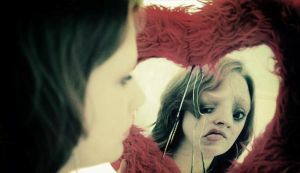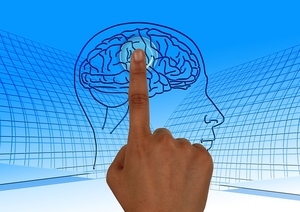 Dysmorphophobia is a disorder of the psyche, in which a person manifests a pathological concern with a small defect or a peculiarity of his appearance.
Dysmorphophobia is a disorder of the psyche, in which a person manifests a pathological concern with a small defect or a peculiarity of his appearance.
The most common pathology, which is also referred to in various sources as dysmorphic disorder, dysmorphobia or bodily dysmorphia develops in adolescents, both in males and females.
Sometimes the disorder turns into a severe disease dysmorphomania at the level of delirium, which is mainly manifested in people who do not like their sex or in patients with schizophrenia.
The main difference between the pathological process and the normal dissatisfaction with its appearance, which is inherent in every person, is obsessive ideas, the emergence of excessive concern about the perception of small defects or the emergence of uncomfortable thoughts about an imaginary shortcoming.
Basically thoughts and obsessions are focused in the face and head area, but can communicate with the rest of the body.
The syndrome of dysmorphophobia transcends the boundaries of normal preoccupation with appearance, worsening the ability to learn, professional activity and interpersonal relationships. In case of serious violations, a person tries not to contact people.
Contents of
- The causes of the pathology of
- The causes of the development of the pathology
- The features of the clinical picture
- Examples from life
- Diagnosis and therapy
- Conducting cognitive-behavioral therapy
- The method of hypnosuggestive psychotherapy
- Conducting group psychotherapy
- Treatment with medicines
- The features of the clinical picture
- The causes of the development of the pathology
Causes of the pathology development
In fact, the appearance of dysmorphophobia can be prompted by the setfactors, but all the reasons can be divided into psychological, biological, personal and media:
- To biologicallym factors include malfunctioning of neurotransmitters, a decrease in the level of serotonin and dopamine;
 hereditary predisposition;generalized anxiety disorder;anomalies of certain brain areas.
hereditary predisposition;generalized anxiety disorder;anomalies of certain brain areas. - The psychological factors of the include mimicking, criticism;world outlook and parental upbringing with a focus on appearance;lack of security, ignorance, rejection.
- Sources of media are also the biggest factor for the emergence of dysmorphofomania syndrome.
- To personal factors , affecting the manifestation of pathology, include several psychological parameters( uncertainty, introversion, perfectionism, neuroses, shyness, not perception or sensitivity to criticism, non-contactness).That is, personal factors can become a trigger mechanism if there is a predisposition to pathology.
Features of the clinical picture
There are numerous symptoms of dysmorphophobia, the main of which is imaginary external unattractiveness or the presence of defects. Patients refuse to look in the mirror, take pictures under different pretexts. But the real reason to be afraid of being photographed is the long-term imprinting of shortcomings.
Dysmorphomanic syndrome is mainly manifested in adolescents, because at this age, attention to appearance, aspiration for a reference model of a certain idol, is increasing. Therefore, it is at this age, often hypertrophied tapering of the impaired disorder in the human psyche.
Sometimes the pathology passes into a severe form, but often it occurs in the form of borderline disorders and with proper therapy is eliminated without a trace.
In the adolescent period, the majority of patients are concerned about their own appearance, they have obsessive movements, insomnia. Adolescents stop talking with friends, learn, abuse drugs or alcohol.
Dysmorphophobia in adolescents during hormonal maturation and enhanced growth of the body can manifest itself in the form of bulimia, anorexia, social phobias, depression. In severe form can result in suicide.
Examples from the life of
 The diagnosis of dysmorphophobia in a person can sometimes change symptoms.
The diagnosis of dysmorphophobia in a person can sometimes change symptoms.
An example of common obsessions can be acne, thoughts of enlarged moles or scars, experiences of large or small amounts of hair, obsessive thoughts about the inappropriate shape or size of the genitals, chest or other parts of the body.
Common examples of obsessive behavior include constant checks of imaginary or minor flaws in front of a mirror, frequent actions to care for your body, avoiding looking at yourself in the mirror. Also, a person can constantly touch or check for deficiencies, use cosmetics excessively or wear certain clothes to camouflage shortcomings, often visit doctors or conduct medical procedures.
Diagnosis and therapy
Diagnosis is established by a psychotherapist or a psychiatrist based on anamnesis, clinical picture. The doctor should determine the nature of dysmorphophobia( overvalued, obtrusive or delusional).The prognosis and treatment are determined by the nature of the underlying disease.
Dysmorphic disorder can only be treated with a professional doctor. The treatment includes complex treatment with the appointment of medications, psychotherapy( mainly with cognitive-behavioral treatment).With this approach, it is possible to correct a pattern that distorts the "image" of the body.
The treatment requires patience and time, as well as support for loved ones. Obsessions and thoughts can disrupt a quality life, deprive a person of energy and pleasure.
Conducting cognitive-behavioral psychotherapy
Cognitive-behavioral therapy methods are used that are effective in treating OCD( cognitive restructuring, when patients are trained to challenge their thoughts).
The EPR method is also applied, which is based on imaginary representations, when short histories with obsessive ideas or thoughts are applied. These stories are recorded and allow the patient to experience the impact of different situations.
By combining standard EPR methods, cognitive-behavioral restructuring, the frequency and volume of imaginary ideas may decrease, and individual sensitivity may decrease. Also, the ability to experience discomfort without using obsessive behavior, seeking assurances develops.
With the use of such tools, patients learn not to perceive imaginary problems, get rid of obsessive thoughts and behavior.
Method of hypnosuggestive psychotherapy
Hypnosis and suggestion( or hypnosuggestive psychotherapy) are also used in the treatment of dysmorphophobia. The method is effective, allowing at unconscious level to consolidate the achieved results of cognitive-behavioral treatment.
Hypnotization is performed with the patient immersing in a certain state with a sharp contraction of consciousness, focusing on suggestion. Also, a person learns self-hypnosis. As a result, after the treatment, unfavorable thoughts, feelings, feelings and images are replaced.
Conducting group psychotherapy
When conducting individual cognitive-behavioral therapy, additional groups are also recruited to treat patients. Based on studies in the treatment of dysmorphophobia, group treatment is effective.
Treatment with medicines
In addition to cognitive-behavioral psychotherapy, antidepressants of SSRIs are added. For the effectiveness of treatment requires at least 20 sessions. The main direction of the use of medicines is the elimination of the consequences of pathology( depression, low  performance).For such purposes, antidepressants, tranquilizers are used. But you can not use medicines for self-medication.
performance).For such purposes, antidepressants, tranquilizers are used. But you can not use medicines for self-medication.
Do not use plastic surgery, which can cause the opposite result and worsen the patient's condition. If dysmorphophobia is manifested as a result of schizophrenia, then the underlying disease should be eliminated.
During a mild form of pathology, communication with the patient about apparent deformities with an authoritative and popular personality may have a good effect. You can also advise him not to hide his shortcomings, but at the same time increase his confidence. It must be forced to transfer its values and focus on something else.
In severe forms of pathology and high risk of suicide, depression, hospitalization of the patient should be made.



